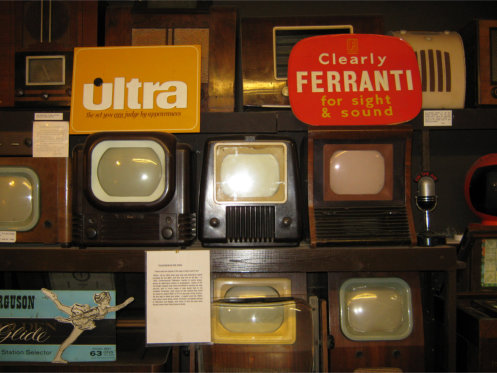 A recent visit to the Amberley Museum and Heritage Centre, near Arundel, West Sussex, has started me thinking about the role of television in our lives over the last 80 years. Amberley Museum has, amongst many other exhibits, an Historic Wireless and Communications collection which contains a number of old televisions. These old black and white sets, mainly from the 1950’s, are housed in large wooden cabinets and have very small screens compared with the slim, ultra wide screen models of today.
A recent visit to the Amberley Museum and Heritage Centre, near Arundel, West Sussex, has started me thinking about the role of television in our lives over the last 80 years. Amberley Museum has, amongst many other exhibits, an Historic Wireless and Communications collection which contains a number of old televisions. These old black and white sets, mainly from the 1950’s, are housed in large wooden cabinets and have very small screens compared with the slim, ultra wide screen models of today.
Television broadcasting in Britain began in London in 1936 using the 405 lines standard in black and white. This service continued on a limited basis until the outbreak of World War II in 1939. Broadcasting resumed after the war ended but it was not until the coronation of Queen Elizabeth II in 1953 that TV ownership really took off. Early televisions were very expensive and it was only in 1956 that commercial television (ITV) started and viewers had a choice of two channels. In the 1960’s moulded plastics came into use displacing the wooden cabinet. Televisions became less like items of furniture and more like functional accessories. In 1964 BBC 2 started broadcasting, initially only in black and white, but by 1967 the first colour TV service started using the 625 lines standard.
Colour television provided an incentive to have larger sets but they still used the Cathode ray tube (CRT) as the picture source. This meant that the sets were very bulky and it was many years before flat screen televisions were to appear. It took until 1985 before all of the old black and white 405 lines transmitters were switched off. Apparently there are still 28000 Black and white TV licences issued each year to people who are using only monochrome televisions. The 1980’s also saw the introduction of the Video Cassette Recorder (VCR) which enabled people to record programmes and rent or buy films to watch at home.
In 1982 Channel 4 started broadcasting and was joined in 1997 by Channel 5. Some 60 years after television first came to Britain terrestrial viewers still only had a choice of 5 channels. In 1989 Sky first started commercial satellite broadcasting in the UK and heralded the multi-channel world we all take for granted today. Around the same time cable television came to Britain but only to large urban areas. Change was also on its way for ordinary viewers when terrestrial digital TV started in 1998. This became Freeview in 2002. In 2007 the changeover from 625 lines to Freeview digital began and was eventually completed in 2012 when the last analogue transmitters were switched off.
It was not until the beginning of C21 that flat screen TVs became widespread and the bulky CRT TVs were replaced. The technology had been around for some time with the plasma screen first being conceived in the 1930’s. Initially plasma TVs were incredibly expensive but prices came down and soon even they were replaced with another technology, LED TVs which now make up most of the sets in use today.
If you are looking at buying a new television then there are a bewildering variety of screen sizes and types available. 3D TVs, “smart†TVs, curved screen, LED, OLED, etc. If money is no object then 85†TVs are now available for approx. £10,000. If your budget is more modest then it is possible to buy a 22†TV for just over £100.
If you are confused by all of this new technology then I can recommend a publication aimed at helping viewers getting the best out of their TV. “Television Viewers Guide†published by Clive Woodyear. It covers Freeview, satellite and cable TV plus internet catch up services. There is also advice on choosing a new TV with diagrams showing how to connect up DVD players, satellite boxes, surround sound systems, etc. Other topics include choosing and installing an aerial, television for caravanners and watching TV in Europe. This 160pp book costs £7.50 (inc postage) and is available through the website www.radioguide.co.uk